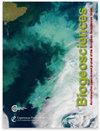底部混合层深度作为地表下叶绿素a分布的指标
IF 3.9
2区 地球科学
Q1 ECOLOGY
引用次数: 0
摘要
摘要初级生产动态与陆架水域的垂直密度剖面密切相关。在层状陆架水域中,海斜坡垂直结构的变化可能会影响营养物通量,从而影响浮游植物的垂直分布和产量。为了了解物理变化对初级生产的影响,确定水柱密度与叶绿素a(Chl a)分布之间的联系至关重要。在这里,描述斜斜的三个不同部分(顶部,中心和底部)的密度特征的垂直分布与Chl a的垂直分布进行了比较,以提供辅助变量来估计陆架水域的Chl a。利用Spearman相关、线性回归和15年的长轴回归,在一个显示分层水柱的陆架区(北海北部)测试了密度特征与深Chl最大值(DCM)的接近性。在1237次观测中,78%的观测结果显示dccm高于底部混合层深度(BMLD:斜斜底部与底部混合层之间的深度),平均距离为2.74±5.21 m。BMLD作为一个垂直边界,在其上,陆架海(深度≤115 m)的次表层Chl a最大值最多。总体而言,dcm与半斜深度(HPD) (ρS = 0.56)相关,结合BMLD比地表混合层指标和最大浮力频率平方值更能预测dcm的位置。这些结果表明,深层混合过程对确定地下生产指示水域的垂直分布有重要贡献,并表明BMLD是陆架海Chl的一个潜在的时间变化指标。提出了一种结合阈值法和最大角度法的分析方法,从原位垂直样品中推断BMLD、表面混合层和DCM。本文章由计算机程序翻译,如有差异,请以英文原文为准。
The bottom mixed layer depth as an indicator of subsurface Chlorophyll a distribution
Abstract. Primary production dynamics are strongly associated with vertical density
profiles in shelf waters. Variations in the vertical structure of the
pycnocline in stratified shelf waters are likely to affect nutrient fluxes and
hence the vertical distribution and production rate of phytoplankton. To
understand the effects of physical changes on primary production,
identifying the linkage between water column density and Chlorophyll a
(Chl a) profiles is essential. Here, the vertical distributions of density
features describing three different portions of the pycnocline (the top,
centre, and bottom) were compared to the vertical distribution of
Chl a to provide auxiliary variables to estimate Chl a in shelf waters. The
proximity of density features with deep Chl a maximum (DCM) was tested using
the Spearman correlation, linear regression, and a major axis regression over 15
years in a shelf sea region (the northern North Sea) that exhibits
stratified water columns. Out of 1237 observations, 78 % reported DCM
above the bottom mixed layer depth (BMLD: depth between the bottom of the
pycnocline and the mixed layer underneath) with an average distance of 2.74 ± 5.21 m from each other. BMLD acts as a vertical boundary above which
subsurface Chl a maxima are mostly found in shelf seas (depth ≤ 115 m).
Overall, DCMs were correlated with the halfway pycnocline depth (HPD) (ρS = 0.56) which, combined with BMLD, were better predictors of the locations
of DCMs than surface mixed layer indicators and the maximum squared buoyancy
frequency. These results suggest a significant contribution of deep mixing
processes in defining the vertical distribution of subsurface production in
stratified waters and indicate BMLD as a potential indicator of the Chl a
spatiotemporal variability in shelf seas. An analytical approach integrating
the threshold and the maximum angle method is proposed to extrapolate BMLD,
the surface mixed layer, and DCM from in situ vertical samples.
求助全文
通过发布文献求助,成功后即可免费获取论文全文。
去求助
来源期刊

Biogeosciences
环境科学-地球科学综合
CiteScore
8.60
自引率
8.20%
发文量
258
审稿时长
4.2 months
期刊介绍:
Biogeosciences (BG) is an international scientific journal dedicated to the publication and discussion of research articles, short communications and review papers on all aspects of the interactions between the biological, chemical and physical processes in terrestrial or extraterrestrial life with the geosphere, hydrosphere and atmosphere. The objective of the journal is to cut across the boundaries of established sciences and achieve an interdisciplinary view of these interactions. Experimental, conceptual and modelling approaches are welcome.
 求助内容:
求助内容: 应助结果提醒方式:
应助结果提醒方式:


